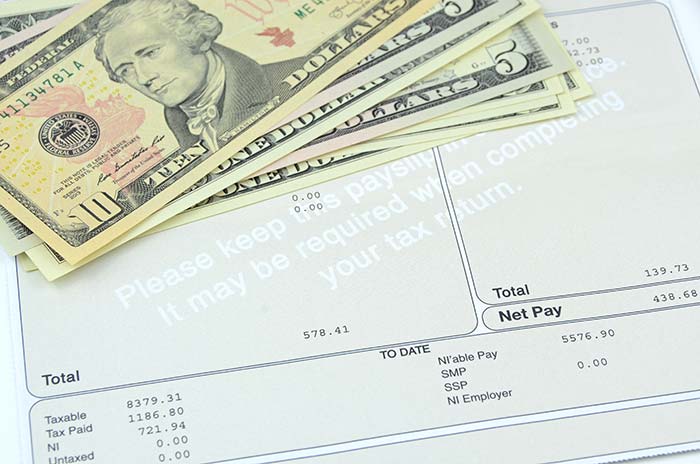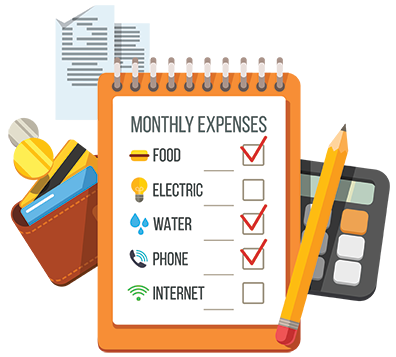The real world is full of subjects not taught in school. With a glimpse into some of those matters, this unit will explore employment, budgets and credit cards, providing an informational foundation for that day when you are out in that real world on your own.
Living independently in the real world requires you to support yourself financially, which means having a job. There are a variety of jobs for people starting out, although many will begin in an entry-level position — that is, a job that requires no specific skills or talents to perform it and one in which you most likely will be trained on the job. Such jobs usually pay the legal minimum wage and can be found by searching online career sites.

Congratulations on landing that job! After the first week or two, depending on if you are paid weekly or biweekly, you will receive a paycheck. The total, called your gross pay, is calculated by multiplying your rate of pay by the number of hours you worked. But — sorry! — you don’t get to keep all the money you just earned. Subtracted from that gross amount are Federal Withholding, Social Security, and Medicare taxes, leaving you with your net pay — the amount you get to take home.
Consider your new home. Do you want more than one bedroom? What about amenities? These are among the questions to answer. Make a list, ranking the items you really must have down to the one you can skip and not miss.
How much you have to spend on an apartment or house depends on your take-home pay. General consensus calls for spending no more than one quarter to one third of net income on housing. Dividing your monthly net pay (from Lesson 2) by 3 will give you a maximum estimate to spend monthly on an apartment or house.
 While it would be nice to buy anything we want after paying rent, we still have other expenses. The easiest way to keep track of these is by creating a budget, which is a listing of the money you have to spend in a week or a month and the things you need to spend that money on.
While it would be nice to buy anything we want after paying rent, we still have other expenses. The easiest way to keep track of these is by creating a budget, which is a listing of the money you have to spend in a week or a month and the things you need to spend that money on.
Your budget has estimated costs and adjusted costs. An estimate is what you think you will spend for the budget time period, and the adjusted number is what you actually spend. For example, your estimate for laundry expenses may come in less than budgeted if your mom does your laundry for you one week.
| Expenses | Estimated Budget | Adjusted Budget |
|---|---|---|
| Housing | ||
| Food | ||
| Transportation | ||
| Clothing | ||
| Insurance/Medical | ||
| Savings | ||
| Fun/Entertainment | ||
| Phone/Utilities | ||
| Other |
You’ve already calculated your net income and your monthly housing expense, which you can enter on the chart. (Net income − housing expense = the amount you have left for your other expense categories.) Did you plan on having a car? If so, how much is your monthly car payment? If having a car is not an option, you should research the cost of using public transportation to get around.
Example (for teacher reference) uses: $7.25/hour × 40 hours = $290 gross ($239.72 net) and a $958.88 monthly take-home pay
| Expenses | Estimated Budget | Adjusted Budget |
|---|---|---|
| Housing | $87.50 ($350 per month) | $87.50 (won’t change weekly) |
| Food | $60.65 | $60.65 |
| Transportation | $10 (75¢ for bus) | $9 ($7.50 for work + a trip for groceries) |
| Clothing | $5 (washer/dryer in apt) | $5 (laundry soap) |
| Insurance/Medical | $20 | $20 |
| Savings | $10 | $10 |
| Fun/Entertainment | $10 | $10 |
| Phone/UtilitiesPhone: $96.28 / 4 = $24.07 Utilities: $30 / 4 = $7.50 |
31.57 | $31.57 |
| Other | $5 | $5 |
Keep track of everything — every penny — you spend in a week’s time. Now add up the cost of items you are not currently paying for, such as the cost of school breakfasts and lunches paid for by your parents. Then estimate the cost of dinners and snacks, of school items, and of items like clothing, gas money, personal hygiene products, etc.
Calculate those monthly expenses. Was it more than you expected? Which figure was most shocking to you?
 Credit cards are a mixed bag. They can be used to pay for something for which you do not have ready cash, but if unchecked, they can lead to debt from which you will have trouble resolving.
Credit cards are a mixed bag. They can be used to pay for something for which you do not have ready cash, but if unchecked, they can lead to debt from which you will have trouble resolving.
The line of credit extended to you is based on your credit score, a three-digit number determined by information in your credit report. The purpose of that score is to predict your risk of becoming delinquent in your credit payments in the 24 months after scoring.
Credit scores range from 300 to 850, with the higher the score, the lower the calculated risk. Several factors with varying weights make up the score formula, including payment history, amount of debt, length of credit history, new credit, and types of credit used. By law, you have the right to a free annual credit report from each reporting agency, but the formula can yield different scores from different reporting agencies, which is among the things that makes credit confusing and hard to manage.
Choosing a credit card can be complicated. The offer you receive in the mailbox might not be a good choice. The first question to ask: “What are the monthly fees?” Some cards require a monthly fee simply to have the credit account — even if you have a zero balance. In addition to the finance charges, other fees can quickly turn your zero balance into a distant memory.
The key to successful use of credit cards is this: Never charge more to the card than you can afford to pay off each month.
This series of lessons was designed to meet the needs of gifted children for extension beyond the standard curriculum with the greatest ease of use for the educator. The lessons may be given to the students for individual self-guided work, or they may be taught in a classroom or a home-school setting. Assessment strategies and rubrics are included at the end of each section. The rubrics often include a column for "scholar points," which are invitations for students to extend their efforts beyond that which is required, incorporating creativity or higher level technical skills.